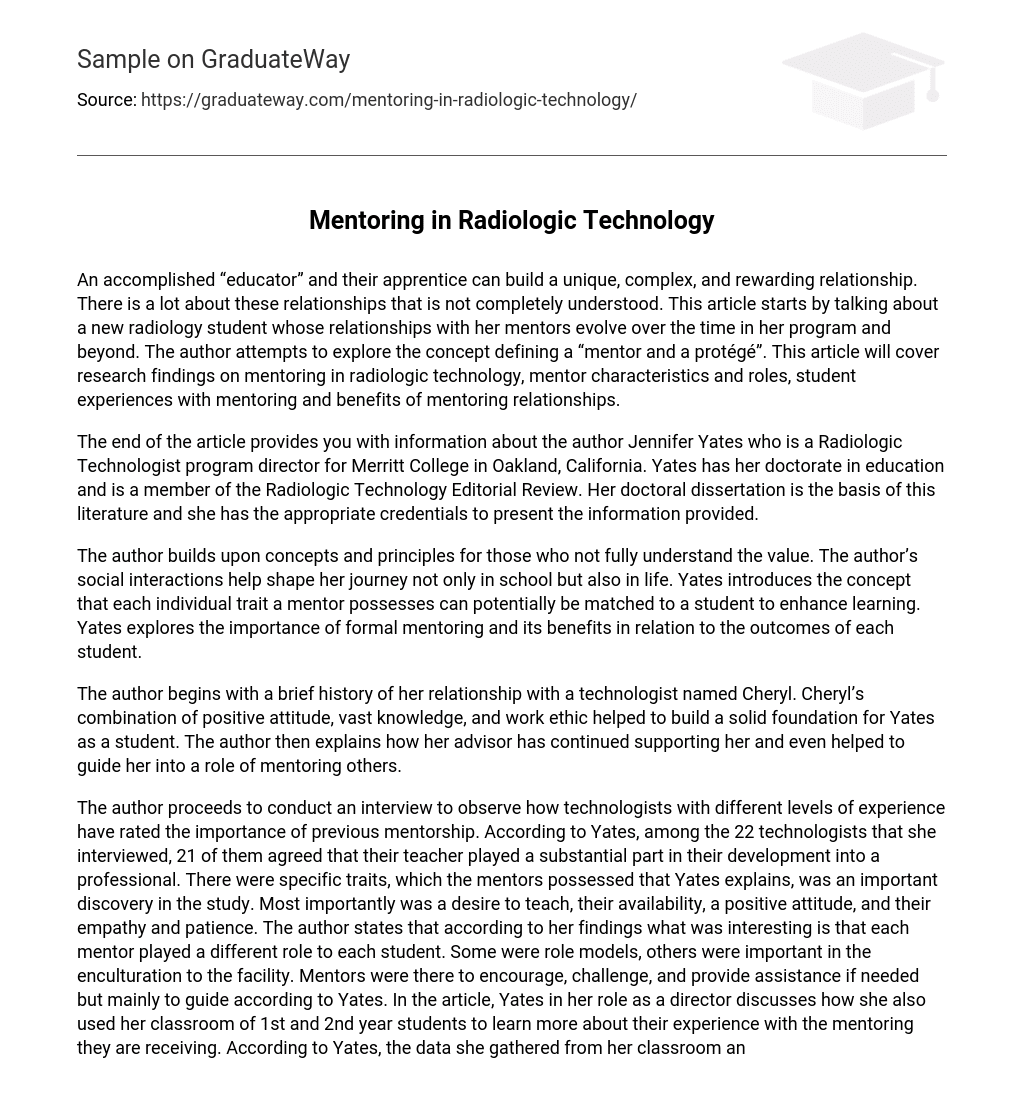An accomplished “educator” and their apprentice can build a unique, complex, and rewarding relationship. There is a lot about these relationships that is not completely understood. This article starts by talking about a new radiology student whose relationships with her mentors evolve over the time in her program and beyond. The author attempts to explore the concept defining a “mentor and a protégé”. This article will cover research findings on mentoring in radiologic technology, mentor characteristics and roles, student experiences with mentoring and benefits of mentoring relationships.
The end of the article provides you with information about the author Jennifer Yates who is a Radiologic Technologist program director for Merritt College in Oakland, California. Yates has her doctorate in education and is a member of the Radiologic Technology Editorial Review. Her doctoral dissertation is the basis of this literature and she has the appropriate credentials to present the information provided.
The author builds upon concepts and principles for those who not fully understand the value. The author’s social interactions help shape her journey not only in school but also in life. Yates introduces the concept that each individual trait a mentor possesses can potentially be matched to a student to enhance learning. Yates explores the importance of formal mentoring and its benefits in relation to the outcomes of each student.
The author begins with a brief history of her relationship with a technologist named Cheryl. Cheryl’s combination of positive attitude, vast knowledge, and work ethic helped to build a solid foundation for Yates as a student. The author then explains how her advisor has continued supporting her and even helped to guide her into a role of mentoring others.
The author proceeds to conduct an interview to observe how technologists with different levels of experience have rated the importance of previous mentorship. According to Yates, among the 22 technologists that she interviewed, 21 of them agreed that their teacher played a substantial part in their development into a professional. There were specific traits, which the mentors possessed that Yates explains, was an important discovery in the study. Most importantly was a desire to teach, their availability, a positive attitude, and their empathy and patience. The author states that according to her findings what was interesting is that each mentor played a different role to each student. Some were role models, others were important in the enculturation to the facility. Mentors were there to encourage, challenge, and provide assistance if needed but mainly to guide according to Yates. In the article, Yates in her role as a director discusses how she also used her classroom of 1st and 2nd year students to learn more about their experience with the mentoring they are receiving. According to Yates, the data she gathered from her classroom and her dissertation study had similar comparisons. Throughout the article, the author provides direct responses from students.
The author then talks about the benefits of mentoring relationships which according to her is “an intense, interpersonal exchange between a less experienced employee and a senior experienced and knowledgeable employee who provides advice, counsel, feedback, and support related to career and personal development” (Yates 17). Yates explains that well mentored students can potentially benefit from increased wages, advancement opportunities and continual gratification from their career. In the article, Yates quotes several texts from Dr. Laurent Daloz in his book titled “Helping Adults Learn: Mentoring and the Definition of a Good Education”. According to Daloz, “good mentors provide 3 purposes for learners to help support, challenge and provide vision” (Daloz 1990). Daloz also believes that students, who are highly challenged and supported, can remain in “stasis” as opposed to those given low support and little challenge. The author ended with a very important study, which was led by three cohorts of radiation therapy students attending University of Texas MD Anderson Cancer center. This study involved the use of the Meyers-Briggs personality test to match a mentor and a student. According is to Yates, the level of confidence in students at graduation increased from 6.3% in 2002 to 72% in 2004. There was also a surge in candidates applying for the program, and an increase of recommendations for it.
In conclusion, the information about the potential benefits of mentors and their students is vast. According to Yates, this relationship should be structured on respect, trust, friendliness and encouragement. She also suggests that well mentored employees are more likely to “pay it forward” and improve the overall organization.





